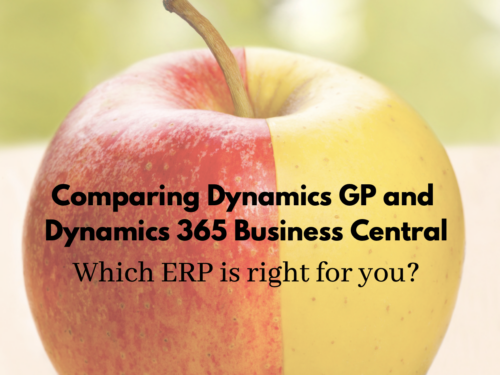Which ERP is right for you?
No two ERPs are the same. While they might have similar capabilities and features, one will likely work better for your needs than another. Today we will take a look at two of Microsoft’s most popular financial software solutions, Microsoft Dynamics GP and Microsoft Dynamics 365 Business Central. We will see how they compare, and help you determine whether or not it makes sense to choose one over the other.
GP on-premise compared to Business Central in the cloud
First, Dynamics GP has long been touted as the “power horse” of Microsoft’s Dynamics ERP solutions. The versatile on-premise ERP debuted in the 1990s and is a popular choice especially in the United States. As the demand for cloud solutions grows, more partners have started offering a hosted option for GP to those clients who prefer to stay on their tried and true product.
In 2018, Microsoft released its first true cloud ERP, a Software as a Service (SaaS) solution known today as Dynamics 365 Business Central. Though the name is relatively new, the cloud solution is heavily based on another ERP — Microsoft Dynamics NAV. In fact, the two solutions are so similar that clients on the on-premise NAV solution can basically “upgrade” to Business Central in the cloud with minimal disruption.
For companies that have a strong preference for either on-premise or cloud software, the difference in deployment options is enough to help them choose a solution. For those who don’t have a preference, you should know that the billing model and upgrade process change significantly based on the deployment method.
How ERP pricing works for GP compared to Business Central
Dynamics GP is priced per concurrent user and includes an annual maintenance fee. This annual fee includes the cost of regular updates. In October of 2019, Microsoft introduced the Modern Lifecycle Policy. The Modern Policy offers continuous support, including bug fixes, new features and the latest tax updates. Customers stay current by taking at least one of the three yearly planned Dynamics GP releases.
Dynamics 365 Business Central, on the other hand, is priced per named user. Like GP, the fee includes the cost of upgrades. Unlike GP, Business Central’s upgrades are installed automatically and do not involve a third party partner.
GP and Business Central are not the same ERP
Some Microsoft clients have incorrectly assumed that BC is simply GP (or NAV) in the cloud. While there are some similarities owing to the fact that both are Microsoft ERP solutions, BC has a very different look and feel from GP. Both have a role-based home page that can be modified, but that’s about where the similarities end.
Business Central has a few extra niceties that are not available in GP. For instance, BC has a search feature and an automatic save feature. In keeping with Microsoft’s goal to unify its software solutions, Business Central also features built-in integrations to Excel, Outlook and other Microsoft technology.
Both financial ERP software solutions include core accounting functionality as well as supply chain management and manufacturing modules. Dynamics GP tends to be a bit stronger on the accounting side. Business Central shines in its supply chain and manufacturing modules. Let’s take a closer look at these unique strengths:
Dynamics GP excels in core accounting
Between GP and Business Central, GP is stronger on core accounting functionality. While Business Central has full accounting capabilities, GP has enhanced features that allow it to handle more complex accounting processes. For example, GP can handle the complexities of fund accounting and has more robust Human Resources features as well as a full Payroll module. In BC, payroll is only available in Business Central via third-party solutions. GP also has capabilities for multiple vendor remit-tos and MICR check printing functionality.
That said, BC has a few extras in the accounting area that GP does not. BC’s use of dimensions to separate entities is easier to use than GP’s analytical accounting, and BC has no issues with stuck batches (a common problem in GP). The cash flow forecasting in BC is better too, because it is based on advanced AI insights.
Business Central features robust manufacturing
Of the two ERPs, Business Central has stronger supply chain and manufacturing capabilities. The cloud ERP has robust supply chain parameters and MRP reports, and its item master list includes options for item variations and user-defined attributes. BC also features strong WMS and bin management, including shipping and receiving documents.
Comparing GP and Business Central going forward
Frequently, Dynamics GP users ask us if GP is going away. The answer is an emphatic “no!” Microsoft is continuing to support its GP solution. However, new features and benefits in the future will be far more abundant within Dynamics 365 Business Central because that’s where Microsoft is focusing their investment.
If you’d like a more in-depth look at how these two ERP solutions compare, check out our calendar for the next session of “Should I Stay or Should I Go? Dynamics GP.” This monthly recurring webinar outlines what you need to know when considering a move from Dynamics GP to Dynamics 365 Business Central.








